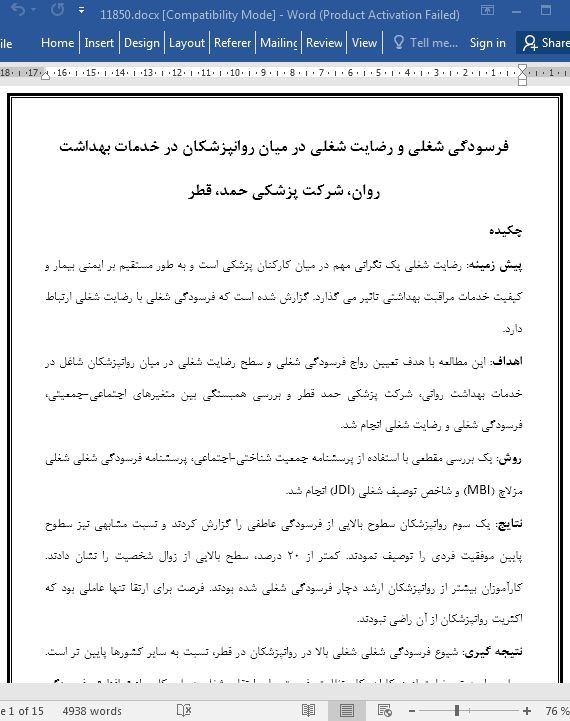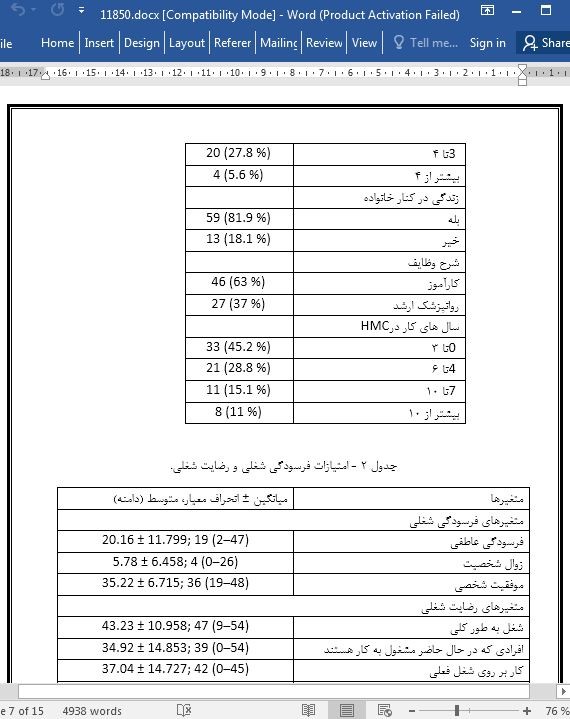
فرسودگی شغلی و رضایت شغلی در میان روانپزشکان در خدمات بهداشت روان
چکیده
پیش زمینه: رضایت شغلی یک نگرانی مهم در میان کارکنان پزشکی است و به طور مستقیم بر ایمنی بیمار و کیفیت خدمات مراقبت بهداشتی تاثیر می گذارد. گزارش شده است که فرسودگی شغلی با رضایت شغلی ارتباط دارد.
اهداف: این مطالعه با هدف تعیین رواج فرسودگی شغلی و سطح رضایت شغلی در میان روانپزشکان شاغل در خدمات بهداشت روانی، شرکت پزشکی حمد قطر و بررسی همبستگی بین متغیرهای اجتماعی-جمعیتی، فرسودگی شغلی و رضایت شغلی انجام شد.
روش: یک بررسی مقطعی با استفاده از پرسشنامه جمعیت شناختی-اجتماعی، پرسشنامه فرسودگی شغلی شغلی مزلاچ (MBI) و شاخص توصیف شغلی (JDI) انجام شد.
نتایج: یک سوم روانپزشکان سطوح بالایی از فرسودگی عاطفی را گزارش کردند و نسبت مشابهی نیز سطوح پایین موفقیت فردی را توصیف نمودند. کمتر از ۲۰ درصد، سطح بالایی از زوال شخصیت را نشان دادند. کارآموزان بیشتر از روانپزشکان ارشد دچار فرسودگی شغلی شده بودند. فرصت برای ارتقا تنها عاملی بود که اکثریت روانپزشکان از آن راضی نبودند.
نتیجه گیری: شیوع فرسودگی شغلی شغلی بالا در روانپزشکان در قطر، نسبت به سایر کشورها پایین تر است. سطوح پایین تر رضایت از همکاران، کار، نظارت، فرصت برای ارتقا و شغل به طور کلی باعث افزایش فرسودگی عاطفی و طوال شخصیت شد. جالب توجه است که رضایت از حقوق، تاثیر قابل توجهی بر فرسودگی شغلی ندارد.
1. مقدمه
1.1 فرسودگی شغلی
در دهه ۱۹۷۰ فرسودگی شغلی به طور فزاینده ای برای توصیف حالت فرسودگی عاطفی، فیزیکی و ذهنی ناشی از استرس شدید و مزمن شناخته شد. به گفته لی و اشفورد (۱۹۹۶)،فرسودگی شغلی یک سندرم خستگی عاطفی (خستگی؛ منابع عاطفی کمتر)، زوال شخصیت (توسعه نگرش های منفی و بدبینانه؛ رفتار غیر شخصی با مشتریان)، و احساس فقدان موفقیت شخصی (افکار بی کفایتی و عدم کفایت) است. فرسودگی شغلی در میان ارائه دهندگان خدمات بهداشتی بسیار شایع است (مورس و همکاران ، 2012)؛ حدود ۶۷ نفر از ارائه دهندگان خدمات بهداشت روان، سطح بالایی از فرسودگی شغلی را تجربه می کنند.
Abstract
Background Job satisfaction is a critical concern among medical staff and directly affects patient safety and quality of health care services. Burnout has been reported to be correlated with job satisfaction.
Aims This study aimed to determine the prevalence of burnout and level of job satisfaction among psychiatrists working in the Mental Health Service, Hamad Medical Corporation, Qatar, and examine correlations among socio-demographic variables, burnout, and job satisfaction.
Method A cross-sectional survey was conducted using a socio-demographic questionnaire, the Maslach Burnout Inventory (MBI), and the Job Descriptive Index (JDI).
Results One-third of psychiatrists reported high levels of emotional exhaustion, with a similar proportion describing low levels of personal accomplishment. Less than 20 % demonstrated high levels of depersonalization. Trainees were more burned out than senior psychiatrists. Opportunities for promotion was the only factor with which the majority of psychiatrists were not satisfied.
Conclusions The prevalence of high burnout in psychiatrists remains lower in Qatar than in other countries. Lower levels of satisfaction with co-workers, work, supervision, opportunities for promotion, and the job in general increased emotional exhaustion and depersonalization. Interestingly, satisfaction with salary did not have a significant effect on burnout.
1. Introduction
1.1. Burnout
Burnout became increasingly recognized in the 1970s to describe a state of emotional, physical, and mental exhaustion caused by excessive and chronic stress. According to Lee and Ashforth (1996), burnout is a syndrome of emotional exhaustion (tiredness; fewer emotional resources), depersonalization (development of negative, cynical attitudes; impersonal treatment of clients), and feelings of a lack of personal accomplishment (thoughts of incompetence and inadequacy). Burnout is highly prevalent among health care providers (Morse et al., 2012); up to 67 % of mental health care providers are estimated to experience high levels of burnout.
چکیده
1. مقدمه
1.1 فرسودگی شغلی
1.2 رضایت شغلی
1.3 مطالعه حاضر
2. روش ها
2.1 شركت كنندگان
2.2. معیارها
2.3 تحلیل آماری
3. نتایج
3.1 داده های جمعیتی - اجتماعی
3.2 فرسودگی شغلی
3.3 رضایت شغلی
3.4 فرسودگی شغلی و رضایت شغلی
3.5 تحلیل رگرسیون متغیرهای رضایت شغلی و مقیاس های فرعی فرسودگی شغلی
4. بحث
4.1 محدودیت ها
منابع
Abstract
1. Introduction
1.1. Burnout
1.2. Job satisfaction
1.3. The present study
2. Methods
2.1. Participants
2.2. Measures
2.3. Statistical analysis
3. Results
3.1. Socio-demographic data
3.2. Burnout
3.3. Job satisfaction
3.4. Burnout and job satisfaction
3.5. Regression analysis of job satisfaction variables and burnout subscales
4. Discussion
4.1. Limitations
References
- اصل مقاله انگلیسی با فرمت ورد (word) با قابلیت ویرایش
- ترجمه فارسی مقاله با فرمت ورد (word) با قابلیت ویرایش، بدون آرم سایت ای ترجمه
- ترجمه فارسی مقاله با فرمت pdf، بدون آرم سایت ای ترجمه



